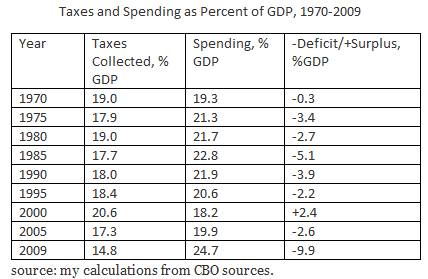Things are much like they were before: the U.S. needs to ensure economic growth in the short term, while developing a path to a long range sustainable budget. During 2011, we have achieved neither, and I see no reason for optimism that legislative action on either front will occur before the 2012 election.
The only way to achieve a long range sustainable budget is for taxes as a percent of GDP to rise over current levels, and spending to decline, also as compared to current levels. The Simpson-Bowles plan proposed achieving balance at 21% of GDP in 2035, which would be the highest level of taxation observed (20.6% in 2000 is previous max), but we routinely spent more than 21% of GDP in the 1970s and 1980s.
If we adopted 21% of GDP as a future target for balancing the budget, we would be saying government spending will be less while the baby boomers are eligible for Medicare and Social Security than it commonly was when they were paying taxes to support these same programs. This will be very hard. Plans seeking balance at lower levels seem implausible.
Now that the Super Committee has not agreed to anything to replace the sequester, the next step toward a long range sustainable budget will either be some clarity from the next election with the knowledge of what the Supreme Court has ruled about the ACA, or some economic calamity that will spur action. The former is possible. The latter is a near certainty, eventually, the question is when and what the crisis looks like?
The only source of optimism I can find is the similarity of the grand bargain deals that include both substantial tax increases and spending cuts (without both, it is not a plan, but a fantasy). If we have to act fast, we really know a great deal about what the last step looks like. We just don’t know what it will take to get us to act.


